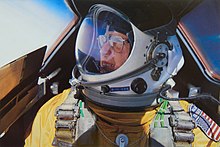Brian Shul
| Brian Shul | |
|---|---|

Brian Shul in the cockpit of the SR-71 Blackbird
|
|
| Born | 1948 Quantico, Virginia |
| Allegiance |
|
| Service/branch |
|
| Years of service | 1970 - 1990 |
| Rank | Major |
| Battles/wars | Vietnam War |
| Other work | Aerial photographer |
Brian Shul (born 1948), is a Vietnam War-era attack pilot and a retired major in the United States Air Force (USAF). He flew 212 combat missions and was shot down near the end of the war. He was so badly burned that he was given next to no chance to live. Surviving, he returned to full flight status, flying the SR-71 Blackbird. Major Brian Shul completed a 20-year career in the Air Force. He has written four books on aviation and runs a photo studio in Marysville, California.
Brian Shul was born in Quantico, Virginia, in 1948. He graduated from Radford High School in Honolulu, Hawaii in 1966 and from East Carolina University in 1970 with a degree in History. That same year he joined the Air Force and attended pilot training at Reese AFB in Texas.
Shul served as a Foreign Air Advisor in the Vietnam War, flying 212 close air support missions in conjunction with Air America. Near the end of all hostilities, his AT-28 aircraft was shot down near the Cambodian border. Unable to eject from the aircraft, Shul was forced to crash land into the jungle. After surviving, he suffered severe burns in the ensuing fireball. Crawling from the burning wreckage, and surviving in hostile territory with extensive wounds for more than a day, he was able to find the most secure location to camouflage himself. There was a point, due to his location, he had patrolling guards within a few yards distance- he was unsure of his judgement and thought they were hallucinations.
The rescue mission was not immediate due to his location having dense enemy numbers, foliage that was even worse for aerial support, and the fact that he could not stay near the crash site. With a combination of resources, his general area was later located and confirmed that there was no body at the crash site. Upon activating his radio, confirming his identity and his general location- so as to prevent enemy attack, although even Shul was not sure exactly where he was, but knew a rough grid. This initiated an aerial search of the area till his exact location was determined by his confirmation of American aircraft in view. The only timely way to recover Shul would be helicopter, and it would likely be under fire, considering those facts along with the recovery plan allocating more than usual time on the ground due to his extensive burns, complex location with enemies, and the fact that he was not sure exactly where he was, the recovery team choice was critical and easy. Conventional forces, such as typical Army Infantry and Medics would not do- the time for them to plan the scenarios that could occur, combined with the larger risk on Shul's and their own lives due to lack of experience, variety of techniques, skills, equipment, and close air integration gave an operation employing small unit tactics with high flexibility in all areas.
...
Wikipedia
